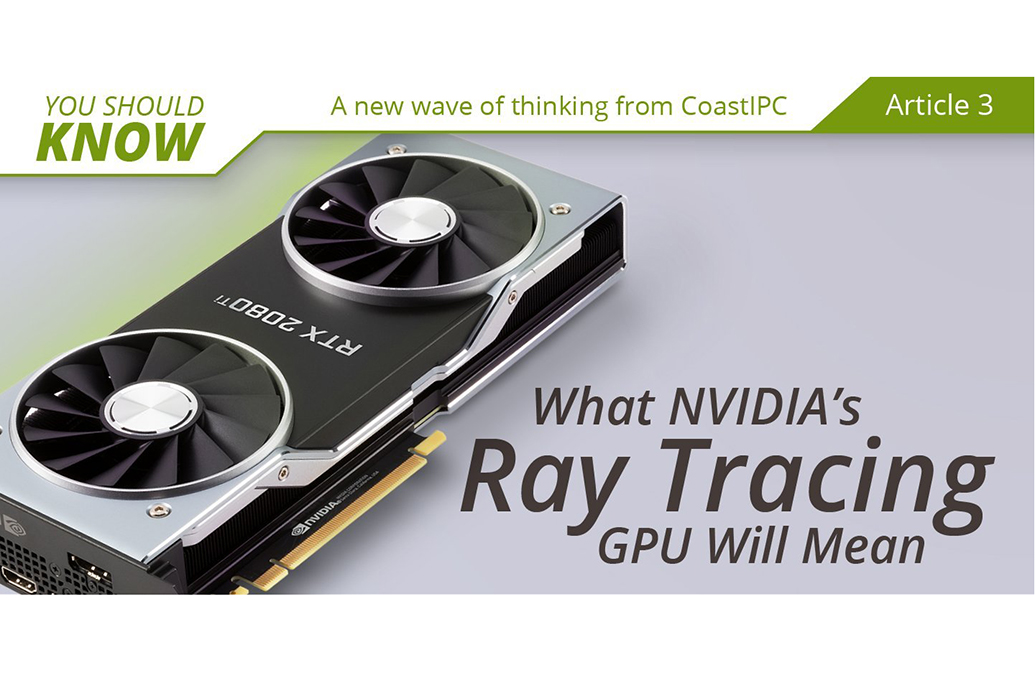
NVIDIA’s RTX™ 2080 Ti will bring emerging GPU-accelerated applications, such as VR, AI, autonomous driving and CUDA computing to a wide range of demanding environments.
Hollywood studios have long known about ray tracing, the technology behind the remarkable photo-realistic 3D graphics that audiences take for granted in many of today’s feature films. It is an extremely compute-intensive technique that models how individual rays, whether directly from a light source or reflected off surrounding surfaces illuminate an object in terms of shadows, coloring, brightness, and other effects. In a studio, the technique can take server farms dozens of hours or even days to render a single frame.
That’s obviously not practical for embedded applications like industrial control and autonomous vehicles — even where a computer’s ability to realistically “see” objects (a person crossing a dark street, for example) would obviously be ideal. That’s because the same computer should also be compact, competitively priced, offer a real-time response, and operate within required thermal limits.
Which is why the NVIDIA® RTX™ 2080 Ti so exciting. For less than a hundred dollars more, and with the same 250-watt power draw, the RTX™ 2080 Ti follows up on its predecessor GPU, the GTX 1080 Ti. The RTX™ 2080 Ti is the first GPU to offer real-time ray tracing. It does this by leveraging another NVIDIA® innovation — Deep Learning Super Sampling (DLSS) — software that runs in Turing’s Tensor cores alongside the GPU’s RT cores. DLSS is a sort of advanced anti-aliasing technique utilizing AI to “fill in the blanks” in an image so that the hardware doesn’t have to. The AI inside DLSS not only helps make the GPU’s ray tracing feature compute-efficient but also enables machine learning and artificial intelligence capabilities that — like ray tracing — are now cost-effective options for the first time in many real-time embedded applications.
Comparison of NVIDIA Pascal GP102 and Turing TU102
| GPU Features | GTX 1080Ti | RTX 2080Ti | Quadro P6000 | Quadro RTX 6000 |
| Architecture | Pascal | Turing | Pascal | Turing |
| GPCs | 6 | 6 | 6 | 6 |
| TPCs | 28 | 34 | 30 | 36 |
| SMs | 28 | 34 | 30 | 36 |
| CUDA Cores / SM | 128 | 64 | 128 | 64 |
| CUDA Cores / GPU | 3584 | 4352 | 3840 | 4608 |
| Tensor Cores / SM | N/A | 8 | N/A | 8 |
| Tensor Cores / GPU | N/A | 544 | N/A | 576 |
| RT Cores | N/A | 68 | N/A | 72 |
| GPU Base Clock MHz | 1480 | 1350 | 1506 | 1455 |
Case in point is our Nuvo-6108-IGN series — the world’s first industrial-grade GPU computers to support high-end graphics cards, including the NVIDIA® GeForce RTX™ 2080 Ti. The patented design guarantees operation at 60˚C under 100% GPU loading, meaning that not only can you now get ray tracing and robust AI in an industrial computer, you also get to use it under very demanding field conditions. We are seeing a lot of interest, for example, from customers in robotics, machine vision, and video surveillance, as well as autonomous driving. The unit is also partitioned so that if the GPU ever goes down the PC will continue to operate uninterrupted. For easy swap-out, the GPU is provided in a fanless one-slot cassette.
All of which goes to show how, as GPU technology continues to advance, so too will the technology that actually unlocks the power of those GPUs in real-world applications. Customers in the embedded space want all this technology delivered holistically, with functionality, performance, and reliability staying in balance.

